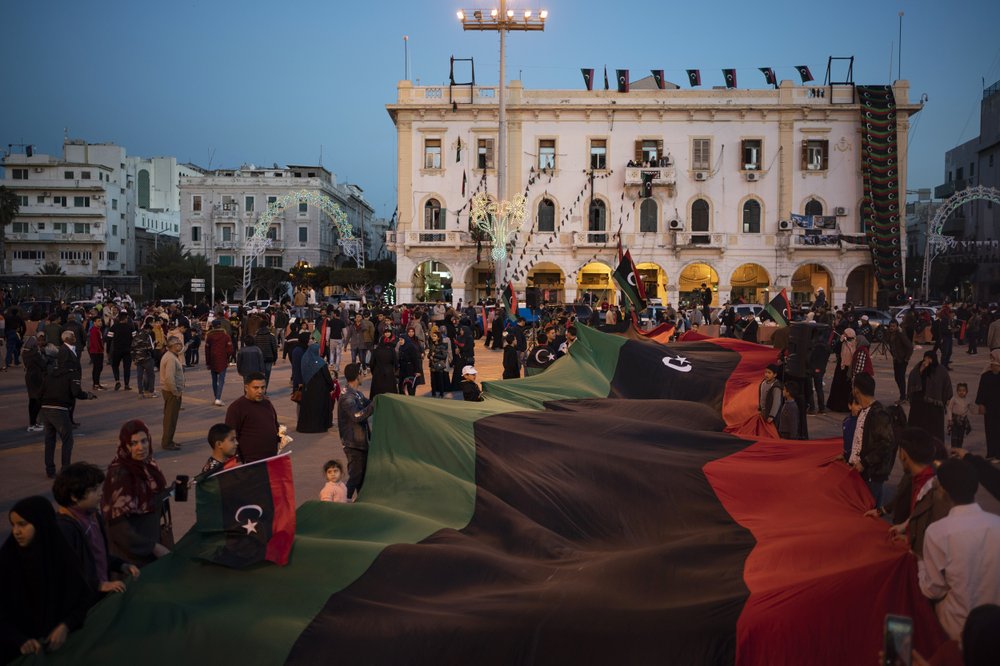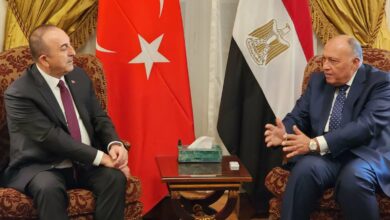Zawiya, Libya–Arab foreign ministers were meeting in Egypt on Saturday to discuss a no-fly zone over Libya as Muammar Qadhafi's regime showed growing confidence after retaking a strategic town near Tripoli following days of relentless shelling against protesters-turned-rebels.
Ahmed bin Helli, the Arab League's undersecretary general, said a no-fly zone proposition was on the agenda for Saturday's emergency meeting. Member states, however, were divided over how to deal with the Libyan crisis, signaling it would be a tough debate.
Qadhafi's regime captured the strategic town of Zawiya and a key oil town in the east Friday as it fought to dislodge rebels who took refuge among towering storage containers of crude oil and gas in nearby facilities.
Zawiya's main square, which had been a key center of resistance to the west of the capital, bore the scars of battle and the streets were lined with tanks as loyalists waving green flags rallied amid a heavy presence of uniformed pro-Qadhafi troops and snipers. There was talk of rebel bodies having been bulldozed away, and the dome and minaret of the nearby mosque were demolished.
With Qadhafi's men also on the march against rebels in the east, Western nations appeared in disarray over how to stop the bloodshed.
President Barack Obama said a no-fly zone over Libya to protect the civilian population from the Qadhafi regime's fighter jets remains a possibility as "we are slowly tightening the noose" around Qadhafi, but he stopped short of moving toward military action.
He cited actions already taken, including getting American citizens and embassy workers out of the country, slapping tough United Nations sanctions on Libya and seizing US$30 billion in Qadhafi's assets.
The European Union, meanwhile, said a no-fly zone would need diplomatic backing from international organizations like the Arab League, which was to discuss situation in Libya on Saturday in Cairo.
The capture of Zawiya, a coastal city of about 200,000 people that is located near an oil port and refineries, seals off a corridor around the capital and solidifies the government's control over the western third of the country to the border with Tunisia. The government still faced a rebel challenge in Misrata, Libya's third-largest city, 200 km (125 miles) southeast of Tripoli.
The government had claimed victory in Zawiya, 50 km (30 miles) west of Tripoli, on Wednesday, but the rebels who are seeking to oust Gadhafi said fighting was ongoing.
An Associated Press reporter, who was taken by the government with other journalists into the city on Friday, said the city was clearly in government control, with Libyan soldiers manning tanks and trucks mounted with anti-aircraft guns.
Grim evidence of battle was everywhere. A makeshift clinic that had been set up inside the mosque to treat the injured was destroyed and the floor was covered with rubble, shoes and glass while the roof was punctured with a large hole where the dome had been.
The facades of buildings, including banks and hotels overlooking Martyrs' Square, were devastated, the streets were strewn with shattered glass and several palm trees had been burned or uprooted.
A 43-year-old government employee said the shelling of the city started on Friday and was nonstop until Wednesday, the day the government claimed victory.
"Many people were killed on Friday. The youth were marching in the square," he said. "I don't know whom to blame–the leader, the son of the leader, the government or the rebels. It was peaceful. I don't know why this happened. I never imagined that I would see Zawiya, my hometown, like this."
He said at least 24 of the protesters had been buried in the square but the pro-Qadhafi forces had used bulldozers to remove their bodies. The claim couldn't be independently verified, although the area was flattened.
Libya's Deputy Foreign Minister Khaled Qaid said the death toll was 14, including rebels and army soldiers.
Anti-Qadhafi graffiti that had covered walls during a previous visit by the AP also had been painted over. Green flags and pictures of Gadhafi were wrapped around some buildings.
Zawiya's fall to the opposition about a week into the uprising that began 15 February illustrated the initial, blazing progress of the movement that started with protests in the east and escalated into an armed rebellion. But Qadhafi has seized the momentum, battering opponents with airstrikes and artillery fire.
Salem Gnan, a member of the Libyan opposition-in-exile, insisted activists would fight back.
"The youths are determined to return to the city and attack again," he said in a telephone interview from London.
A heavy crackdown by pro-Qadhafi militiamen also apparently has succeeded in stifling attempts at protests in the capital.
Inspired by the ouster of leaders in Egypt and Tunisia, Qadhafi's opponents have attempted to hold protests every Friday for the past few weeks, but they have been met each time by a fierce retaliation from militiamen and no attempts were reported on Friday.




